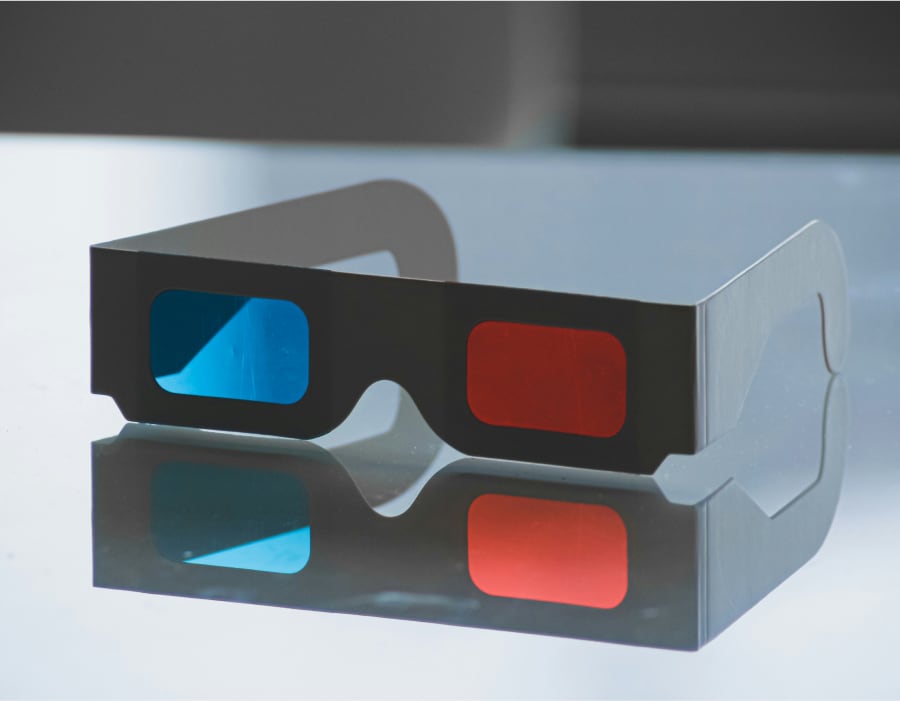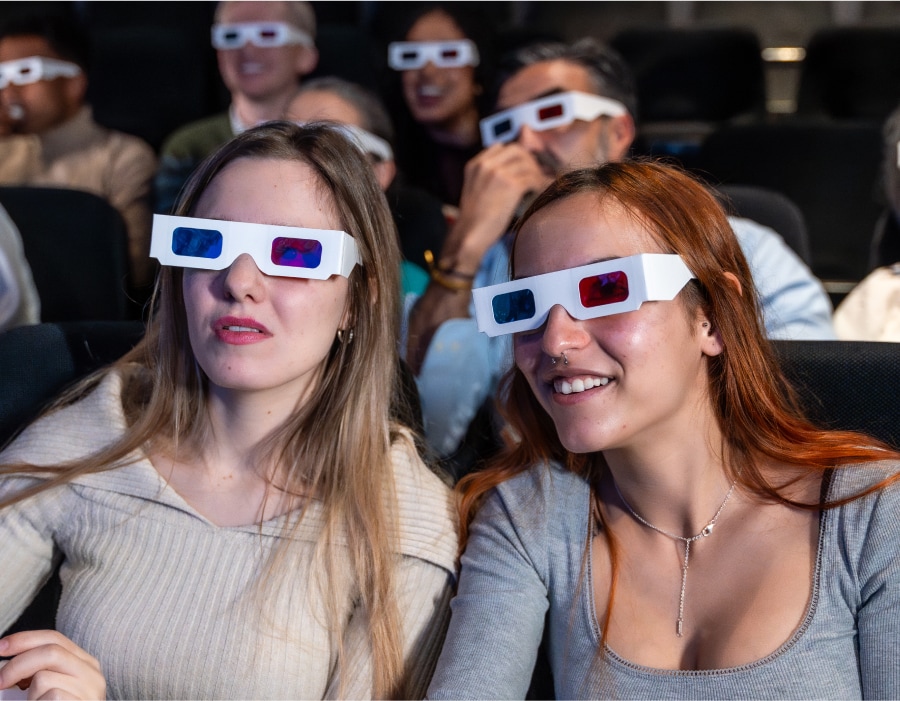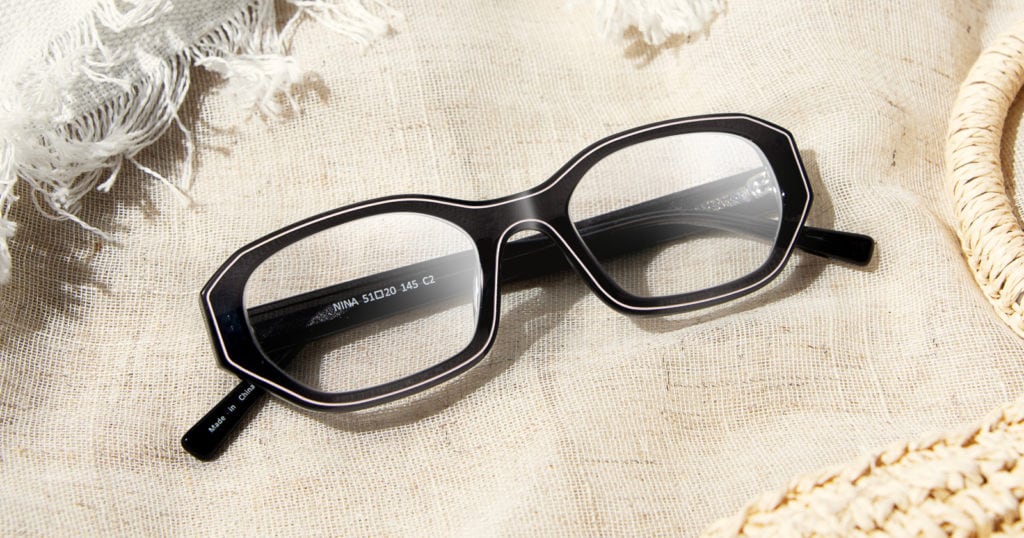From the cheesy red and blue lenses of mid-20th-century cinema to the sleek, sophisticated digital glasses of today, 3D glasses have undergone a fascinating evolution. They’re more than just a trend. They use clever optical technology to trick our brains into seeing depth that isn’t really there.
Below, we cover what 3D glasses are and how they alter visual perception to create a magical viewing experience.

History of 3D Glasses
3D glasses have evolved significantly since their inception. Initially, they featured simple red and blue lenses housed in cardboard frames. Since then, they’ve transformed into sophisticated eyewear that enhances users’ viewing experiences.
3D glasses work on the principle of stereoscopy. This mimics how our eyes see depth in the real world. By presenting two slightly different images, one to each eye, they create a 3D effect. You can use different methods to do this. For example, anaglyph glasses use color filters, and polarized glasses use light polarization.
The journey to more modern 3D eyewear began in the early 1900s with anaglyph glasses. These glasses, with their two differently colored lenses, created depth that allowed viewers to perceive images in 3D. As technology advanced, new types such as polarized and active shutter glasses emerged, each offering distinct features.
3D glasses have greatly improved movie experiences. They are now also popular in gaming and virtual reality. The future of 3D glasses looks bright. As technology advances, we can expect more fun and interactive experiences. 3D glasses add excitement to entertainment, whether you’re watching a big movie or exploring a virtual world. They make the experience feel more real and immersive.
Types of 3D Glasses
3D glasses use different methods to manipulate visual perception. This is how the different types of 3D glasses are distinguished. Below, we go into further detail about these types and how they each produce false depth perception.
Understanding the different kinds of 3D glasses can help you select the optimal pair, whether you’re watching a movie at home or enjoying an amusement park ride.
Anaglyph 3D Glasses
Anaglyph 3D glasses are known for their red-cyan lenses that many recognize from childhood. These glasses filter images through two colored lenses, allowing one color through each lens to create a 3D effect.
This type of 3D glasses is simple and affordable, making them especially popular for home use and education. But they compromise image quality and color accuracy. This limits their suitability with modern high-definition media.
Polarized 3D Glasses
Polarized 3D glasses are an improvement over anaglyph technology. They use polarized lenses, which filter out reflected light to cut glare and improve clarity, to separate images for each eye. This offers a more natural and vibrant view.
Popular in cinemas and theme parks, polarized 3D glasses provide a clearer experience without the color limitations of anaglyph glasses. They are lightweight and comfortable for extended wear but require special screens or projectors, which limit their use to specific settings.
Active Shutter 3D Glasses
Active shutter 3D glasses offer the pinnacle of 3D technology. These glasses feature battery-powered lenses that alternately block each eye in time with the display. This produces a high-definition 3D effect.
They deliver full-color, high-resolution images, making them ideal for home theaters and gaming. They’re also compatible with various devices like TVs and projectors. With this in mind, they are often more expensive and require charging, which might be a concern for some users.

How 3D Glasses Improve Your Viewing Experience
3D glasses have revolutionized the way we watch movies and play games by introducing a sense of depth that makes you feel part of the action. This is achieved by displaying two slightly different images to each eye, which your brain combines into a single 3D image.
Here’s how 3D glasses enhance different forms of entertainment:
Film
- Enhances action scenes and dramatic landscapes for a more engaging visual experience
- Used in movies like Avatar and Gravity to deepen immersion and redefine storytelling
- Helps audiences feel more connected to the world on screen
Gaming
- Improves depth perception for more realistic gameplay
- Makes fast-paced sequences and detailed environments more engaging
- Boosts the sense of being inside the game world
Virtual Reality (VR)
- Relies on 3D glasses to create a convincing and interactive environment
- Allows users to explore virtual worlds with lifelike detail and motion
- Plays a central role in delivering realism and immersion in VR headsets
Choosing the Right 3D Glasses
Selecting the right 3D glasses is vital for achieving an optimal viewing experience. Pay attention to compatibility with your devices as well as the comfort and style of the glasses. Here are some things to consider:
Compatibility with Devices
Ensure the 3D glasses are compatible with your devices. TVs, projectors, and gaming consoles may each require different glasses.
Active shutter glasses are typically used with TVs and projectors. They are best suited for high-definition displays. Polarized 3D glasses are commonly found in cinemas and some home theaters. These glasses are lightweight and battery-free, ideal for lengthy movies. However, not all devices support them, so check your device specifications beforehand.
For gamers, certain 3D glasses enhance depth and realism, particularly on consoles such as the Xbox 360. Verify that your selected glasses are compatible with your console.
Comfort and Design
When selecting 3D glasses, comfort should be a top priority, especially if you’ll be wearing them for long periods. Look for features that improve fit and reduce pressure on your face, such as:
- Lightweight frames that sit comfortably without causing strain
- Adjustable nose pads to customize the fit around your nose
- Flexible frame arms that contour to your face and stay secure
Design also plays a key role in overall experience. Choose stylish 3D glasses that reflect your personality while maintaining functionality. A design you appreciate will further enhance your overall experience.

Future of 3D Glasses Technology
The future of 3D glasses is on the cusp of significant advancements. Emerging technologies are set to redefine how we experience 3D visuals. They aim not only to enhance visuals but also to make experiences more interactive and engaging.
The integration of augmented reality (AR) and virtual reality (VR) with 3D glasses is creating intriguing possibilities. This combination allows for interaction with both real and virtual worlds. Imagine watching a movie where characters seem to step into your living room — AR and VR make such experiences increasingly feasible.
Another pivotal development is glasses-free 3D viewing. This technology utilizes advanced screens to display 3D images without glasses by sending different images to each eye, crafting a 3D view. It could revolutionize how we watch films and play games by enhancing comfort and accessibility.
Improvements in lens materials and designs are making 3D glasses lighter and more comfortable, reducing eye strain and refining viewing experiences. Some companies are even experimenting with lenses that adapt to changing lighting for clearer images.
Artificial intelligence (AI) is influencing the future of 3D glasses by enhancing image quality and rendering visuals sharper and more realistic. AI can also personalize the 3D experience based on viewer preferences and content.
The outlook for 3D glasses is promising. As developments in AR, VR, lens technology, and AI progress, 3D experiences will become more immersive and comfortable for everyone. These innovations will transform how we watch movies, play games, and interact with digital content.

Where Innovation Meets Everyday Vision
While 3D glasses continue to evolve and push the boundaries of immersive entertainment, they remain a specialized category within eyewear. For everyday vision needs—whether you’re looking for stylish frames, blue light protection, or prescription lenses—retailers like Eyebuydirect offer a wide selection of affordable, high-quality options.
As technology advances in both 3D and traditional eyewear, there’s never been a better time to find glasses that match your lifestyle.




